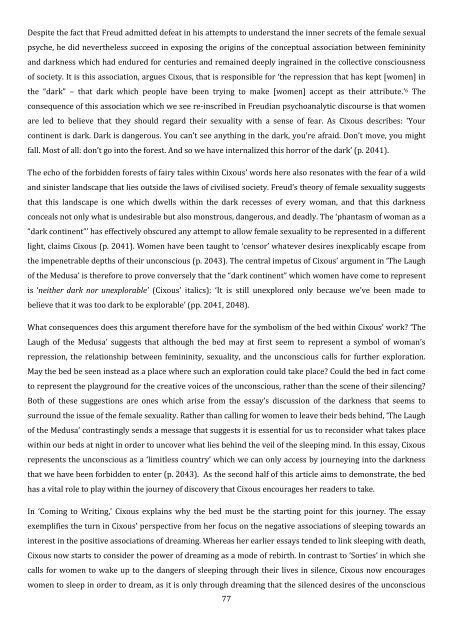download this issue as a PDF
download this issue as a PDF
download this issue as a PDF
Create successful ePaper yourself
Turn your PDF publications into a flip-book with our unique Google optimized e-Paper software.
Despite the fact that Freud admitted defeat in his attempts to understand the inner secrets of the female sexual<br />
psyche, he did nevertheless succeed in exposing the origins of the conceptual <strong>as</strong>sociation between femininity<br />
and darkness which had endured for centuries and remained deeply ingrained in the collective consciousness<br />
of society. It is <strong>this</strong> <strong>as</strong>sociation, argues Cixous, that is responsible for ‘the repression that h<strong>as</strong> kept [women] in<br />
the “dark” – that dark which people have been trying to make [women] accept <strong>as</strong> their attribute.’ 6 The<br />
consequence of <strong>this</strong> <strong>as</strong>sociation which we see re-inscribed in Freudian psychoanalytic discourse is that women<br />
are led to believe that they should regard their sexuality with a sense of fear. As Cixous describes: ‘Your<br />
continent is dark. Dark is dangerous. You can’t see anything in the dark, you’re afraid. Don’t move, you might<br />
fall. Most of all: don’t go into the forest. And so we have internalized <strong>this</strong> horror of the dark’ (p. 2041).<br />
The echo of the forbidden forests of fairy tales within Cixous’ words here also resonates with the fear of a wild<br />
and sinister landscape that lies outside the laws of civilised society. Freud’s theory of female sexuality suggests<br />
that <strong>this</strong> landscape is one which dwells within the dark recesses of every woman, and that <strong>this</strong> darkness<br />
conceals not only what is undesirable but also monstrous, dangerous, and deadly. The ‘phant<strong>as</strong>m of woman <strong>as</strong> a<br />
“dark continent”’ h<strong>as</strong> effectively obscured any attempt to allow female sexuality to be represented in a different<br />
light, claims Cixous (p. 2041). Women have been taught to ‘censor’ whatever desires inexplicably escape from<br />
the impenetrable depths of their unconscious (p. 2043). The central impetus of Cixous’ argument in ‘The Laugh<br />
of the Medusa’ is therefore to prove conversely that the “dark continent” which women have come to represent<br />
is ‘neither dark nor unexplorable’ (Cixous’ italics): ‘It is still unexplored only because we’ve been made to<br />
believe that it w<strong>as</strong> too dark to be explorable’ (pp. 2041, 2048).<br />
What consequences does <strong>this</strong> argument therefore have for the symbolism of the bed within Cixous’ work? ‘The<br />
Laugh of the Medusa’ suggests that although the bed may at first seem to represent a symbol of woman’s<br />
repression, the relationship between femininity, sexuality, and the unconscious calls for further exploration.<br />
May the bed be seen instead <strong>as</strong> a place where such an exploration could take place? Could the bed in fact come<br />
to represent the playground for the creative voices of the unconscious, rather than the scene of their silencing?<br />
Both of these suggestions are ones which arise from the essay’s discussion of the darkness that seems to<br />
surround the <strong>issue</strong> of the female sexuality. Rather than calling for women to leave their beds behind, ‘The Laugh<br />
of the Medusa’ contr<strong>as</strong>tingly sends a message that suggests it is essential for us to reconsider what takes place<br />
within our beds at night in order to uncover what lies behind the veil of the sleeping mind. In <strong>this</strong> essay, Cixous<br />
represents the unconscious <strong>as</strong> a ‘limitless country’ which we can only access by journeying into the darkness<br />
that we have been forbidden to enter (p. 2043). As the second half of <strong>this</strong> article aims to demonstrate, the bed<br />
h<strong>as</strong> a vital role to play within the journey of discovery that Cixous encourages her readers to take.<br />
In ‘Coming to Writing,’ Cixous explains why the bed must be the starting point for <strong>this</strong> journey. The essay<br />
exemplifies the turn in Cixous’ perspective from her focus on the negative <strong>as</strong>sociations of sleeping towards an<br />
interest in the positive <strong>as</strong>sociations of dreaming. Where<strong>as</strong> her earlier essays tended to link sleeping with death,<br />
Cixous now starts to consider the power of dreaming <strong>as</strong> a mode of rebirth. In contr<strong>as</strong>t to ‘Sorties’ in which she<br />
calls for women to wake up to the dangers of sleeping through their lives in silence, Cixous now encourages<br />
women to sleep in order to dream, <strong>as</strong> it is only through dreaming that the silenced desires of the unconscious<br />
77
















